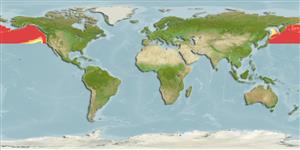>
Myctophiformes (Lanternfishes) >
Myctophidae (Lanternfishes) > Myctophinae
Etymology: Protomyctophum: Greek, pro = first, in front of + Greek, mykter, -eros = nose + Greek, ophys = serpent (Ref. 45335).
Eponymy: William Francis Thompson (1888–1965) was a fishery biologist. [...] (Ref. 128868), visit book page.
Environment: milieu / climate zone / depth range / distribution range
Ökologie
seewasser bathypelagisch; tiefenbereich 785 - 1500 m (Ref. 50550). Deep-water; 66°N - 38°N
North Pacific: Japan (Ref. 559), the Kuril-Kamchatka Trench and the Bering Sea eastward to the Gulf of Alaska south to Baja California.
Size / Gewicht / Alter
Maturity: Lm ? range ? - ? cm
Max length : 5.2 cm SL Männchen/unbestimmt; (Ref. 37815)
Kurzbeschreibung
Bestimmungsschlüssel | Morphologie | Morphometrie
Rückenflossenstacheln (insgesamt) : 0; Rückenflossenweichstrahlen (insgesamt) : 11 - 13; Afterflossenstacheln: 0; Afterflossenweichstrahlen: 21 - 25; Wirbelzahl: 37 - 39. Adipose fin moderate (Ref. 6885). Metallic blue dorsally, bright silvery ventrally (Ref. 6885). Branchiostegal rays: 8-9 (Ref. 31442).
Epipelagic to mesopelagic (Ref. 31442). Oviparous, with planktonic eggs and larvae (Ref. 31442).
Life cycle and mating behavior
Geschlechtsreife | Fortpflanzung | Ablaichen | Eier | Fecundity | Larven
Masuda, H., K. Amaoka, C. Araga, T. Uyeno and T. Yoshino, 1984. The fishes of the Japanese Archipelago. Vol. 1. Tokai University Press, Tokyo, Japan. 437 p. (text). (Ref. 559)
IUCN Rote Liste Status (Ref. 130435: Version 2024-1)
Bedrohung für Menschen
Harmless
Nutzung durch Menschen
Tools
Can't connect to MySQL database fbquizv2. Errorcode: Too many connections
